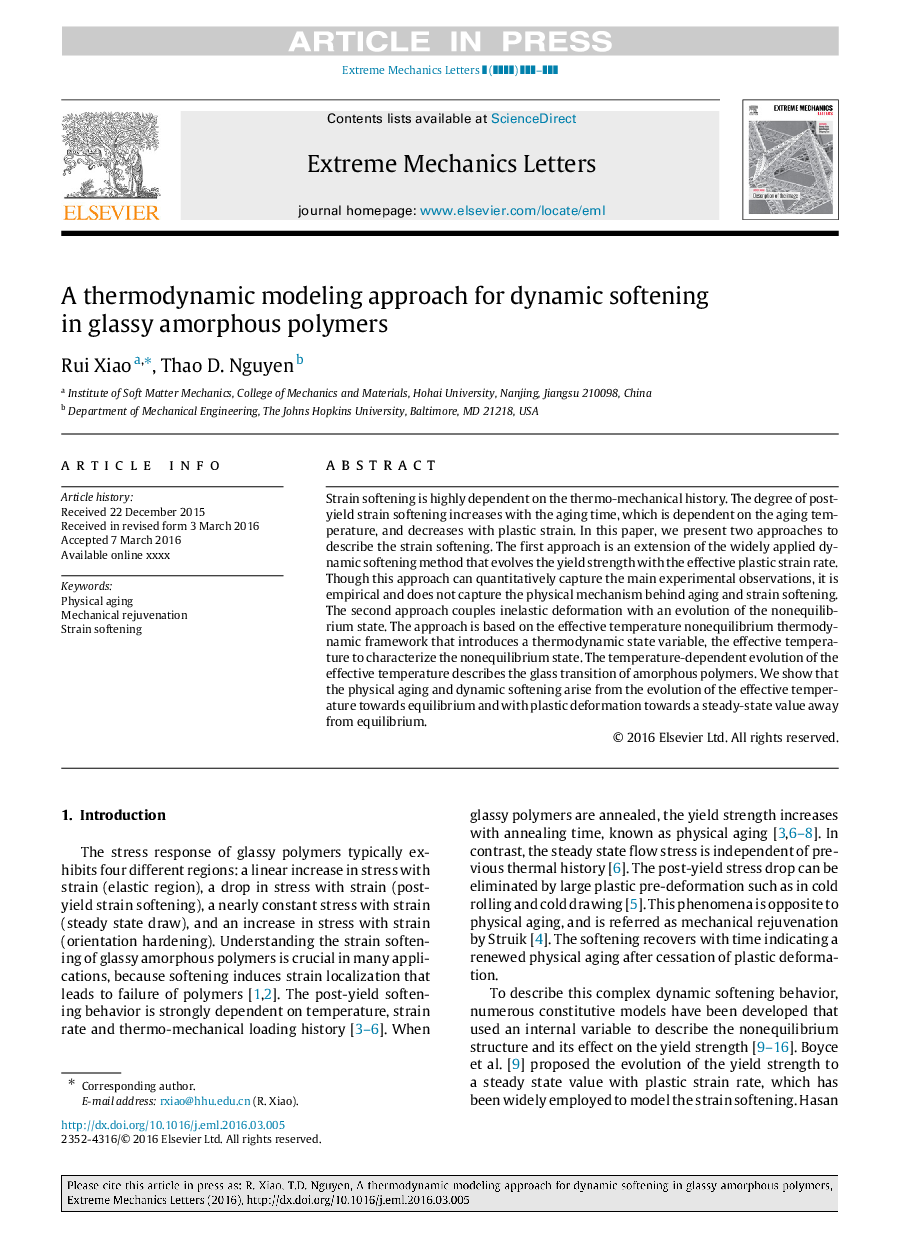| کد مقاله | کد نشریه | سال انتشار | مقاله انگلیسی | نسخه تمام متن |
|---|---|---|---|---|
| 5014581 | 1463303 | 2016 | 8 صفحه PDF | دانلود رایگان |
عنوان انگلیسی مقاله ISI
A thermodynamic modeling approach for dynamic softening in glassy amorphous polymers
ترجمه فارسی عنوان
یک روش مدلسازی ترمودینامیکی برای نرم کردن پویا در پلیمرهای آمورف شیشه ای
دانلود مقاله + سفارش ترجمه
دانلود مقاله ISI انگلیسی
رایگان برای ایرانیان
کلمات کلیدی
پیری فیزیکی، جوانسازی مکانیکی، نرم کننده نرم کننده
ترجمه چکیده
نرم کننده نرمی به شدت وابسته به تاریخ حرارتی مکانیکی است. میزان استحکام کششی پس از تولید با زمان پیری افزایش می یابد که بستگی به دمای پیری دارد و با فشار پلاستیکی کاهش می یابد. در این مقاله، دو روش برای توصیف نرم کردن فشار وجود دارد. اولین رویکرد، توسعه یک روش نرم افزاری پویا به طور گسترده ای است که توانستن عملکرد را با نرخ کشش پلاستیکی موثر می سازد. اگر چه این رویکرد می تواند مشاهدات تجربی اصلی را ضبط کند، اما تجربی است و مکانیسم فیزیکی را در کنار پیری و نرم کردن فشار ایجاد نمی کند. رویکرد دوم تغییر شکل ناپذیری را با تکامل حالت ناپیوستگی روبرو می کند. این رویکرد بر پایه چارچوب ترمودینامیکی غیرمترجمعی درجه حرارت موثر است که یک متغیر حالت ترمودینامیکی را نشان می دهد، که دمای موثر برای تعیین وضعیت ناپیوستگی است. تکامل وابسته به دمای دما موثر انتقال شیشه ای پلیمرهای آمورف را توصیف می کند. ما نشان می دهیم که پیری فیزیکی و نرم شدن پویا از تکامل دمای موثر به سمت تعادل و با تغییر شکل پلاستیک به سمت یک مقدار پایدار به دور از تعادل ایجاد می شود.
موضوعات مرتبط
مهندسی و علوم پایه
مهندسی انرژی
مهندسی انرژی و فناوری های برق
چکیده انگلیسی
Strain softening is highly dependent on the thermo-mechanical history. The degree of post-yield strain softening increases with the aging time, which is dependent on the aging temperature, and decreases with plastic strain. In this paper, we present two approaches to describe the strain softening. The first approach is an extension of the widely applied dynamic softening method that evolves the yield strength with the effective plastic strain rate. Though this approach can quantitatively capture the main experimental observations, it is empirical and does not capture the physical mechanism behind aging and strain softening. The second approach couples inelastic deformation with an evolution of the nonequilibrium state. The approach is based on the effective temperature nonequilibrium thermodynamic framework that introduces a thermodynamic state variable, the effective temperature to characterize the nonequilibrium state. The temperature-dependent evolution of the effective temperature describes the glass transition of amorphous polymers. We show that the physical aging and dynamic softening arise from the evolution of the effective temperature towards equilibrium and with plastic deformation towards a steady-state value away from equilibrium.
ناشر
Database: Elsevier - ScienceDirect (ساینس دایرکت)
Journal: Extreme Mechanics Letters - Volume 8, September 2016, Pages 70-77
Journal: Extreme Mechanics Letters - Volume 8, September 2016, Pages 70-77
نویسندگان
Rui Xiao, Thao D. Nguyen,
